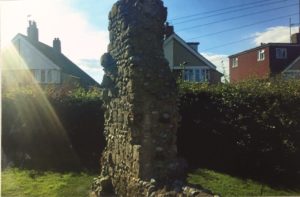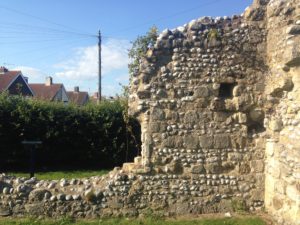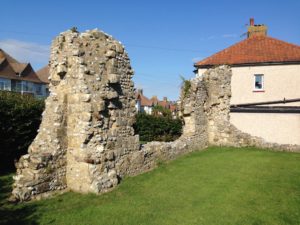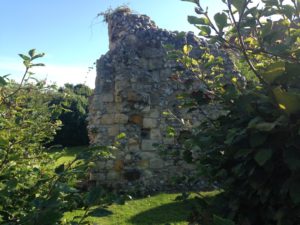Amongst the gardens of suburbia, Alex Woodcock goes in search of a centuries-old ruin.

The road follows the curve of the coast. At its sharpest bend, just past the retail complex and the garage, it rises, turns and descends. If you follow it far enough eastwards there are factories, some new warehouse-style shops and a small railway siding with long corrugated sheds for train maintenance. But I am not going that far. I’m here for the old chapel that hides on the top of the hill, camouflaged by suburban gardens and a landmark pub.
Ever since I was a child I knew this place was old. We’d pass it in the car on occasional trips from Bexhill into Hastings, the swift ascent and descending S-bend lending some excitement to the otherwise flat road. The pub, with its half-timbered, white façade, struck a slightly bleak tone on some days and I was often glad once we’d passed it. Perhaps it was because I was obsessed with ghosts, secret tunnels, smugglers and the like, remnants of the past that had crossed over into the present via stories and legends and continued to live on, that I felt wary of this place. I did not know then, that just behind it was something even older, the remains of the church of St Mary, Bulverhythe, archaically known as Eye Chapel due to its position on an ‘eye’ or former island, for several centuries already a ruin.
I’m looking for stones, of course. Carved stones, fragments of former architecture. Excavations in the 1860s and the 1930s revealed the full size of what must have been an impressive later medieval church: one hundred and one feet long and twenty-four feet wide. In the process of excavation several carved stones were found, Romanesque ones that suggested an earlier church stood there before its enlargement in the thirteenth and fourteenth centuries. These stones featured a head, some geometric patterns and a section of moulding, and as far as I can find out have long since vanished in the way that carved stones often do. But I’ve also learned that there are some further reused ones in the upstanding masonry which may be of the same date. It’s these I’ve come to try and find.

Like coasts around the country this is an area marked by change and loss. By the close of the seventeenth century much of medieval Bulverhythe, once the main harbour for nearby Hastings, had disappeared beneath the sea. The town had been in decline for centuries already, however. Dramatic cliff collapses, inundations of the salt marshes, causeways regularly being swept away and in the late fourteenth century, regular attacks from the French, all contributed to its slow decline. The last priest, William Tracy, was recorded in 1452 and by the time of Richard Budgeon’s map of Sussex in 1724 the church is noted as ruinous. In an engraving made in the early 1800s the ruins are substantial, picturesque spikes of masonry against which blousy shrubs and trees bend in a gentle salt-breeze, the coastline disappearing into the distance behind. In the 1930s the land and the remains were given to the council who promptly built the housing estate around and over them, demolishing the remains of the tower and the nave.
It’s an easy walk from Bexhill on a good day. Along the beach, past the slumped beds of Wealden Sandstone that form the cliffs at Galley Hill, along the footpath and under the railway line. A right turn and up the hill, across the road and into Bexleigh Avenue. The sun is out as the scraps of masonry come into view. Echoing the nineteenth-century engraving with its swaying trees, there is a hedge and some glossy-leaved shrubs partially concealing the site which, on entering through a small gate, form a small and well-maintained public garden. The houses are really close and I struggle to shake the feeling that I am being watched, overlooked as it is by bedroom windows and net curtains. Domestic noises float around the masonry. Someone is vacuuming; some children are playing in a nearby garden; a lawnmower hums in the distance. There is a bench and a plaque with details about the church. Reading it I’m transfixed by the strange mixture of the suburban and the sacred, a place where the dead might dream only feet away from someone making a sandwich.

In his book Sculpture, the artist Philip Rawson wrote a memorable paragraph about the carvings on churches and cathedrals. His book, discovered many years back during my shifts at a university arts library in which I’d managed to get a part-time job as a librarian before I became a stonemason, is still one of my favourites on the subject. Rawson was a respected academic as well as an artist and his writing, spare and to the point, suggested he was not one to entertain anything woozy or uninformed. This made his line about medieval sculpture stand out: according to him, the architectural carvings on buildings, for example, gargoyles and grotesques, contained ‘live spiritual energies’ in their forms. The phrase stuck in my brain. The more I got to know sculptors and stone-carvers in the years that followed, the more it seemed to me that this was how many of them understood their work too. Forms were inhabited; the material held something that lived. This could mean anything from the effort that they’d put into it, like a recording of a conversation, to a document of the days spent doing it to the entirely metaphysical. The stones held the invisible, things only felt, maybe, indeed, the spirits.
If the drab housing that lines the main road from Bexhill to Hastings disguises the former importance of the place, it has been close to, if not at the centre of, some dramatic events. In December 1943 the B-17 bomber nicknamed ‘Unstable Mabel’ came down at night on the flooded recreation ground behind the roadside houses following a gruelling twelve-hour mission over occupied France, its descent lit only by the waxing moon and the fire consuming one of its four engines. The crew, apart from the pilot, had bailed out over the coast and landed safely. Minutes later the plane did similarly, an extraordinary event given the conditions, demolishing a small cricket pavilion as it slid to a halt in the back gardens of three houses. The pilot was unharmed.
Not so the crew of the beleaguered ship Amsterdam, sailing from Texel to Jakarta, which ran aground at Bulverhythe in January 1749 after drifting rudderless in Pevensey Bay due to a storm. Over several days it sunk into the soft sand, where the eighteenth-century wreck still remains in surprising completeness and on a very low tide can still be walked out to. Many of those onboard were already dead from disease, their bodies brought for burial here at the ruinous church. Stories persist about looted chests of silver and some cargo is still presumed to be within the ship, encased by the shifting sands and muds, a monument to the unstable geology of this stretch of coast.

The walls of the church echo these sediments, showcasing a patchwork of south coast geology. Warm-coloured sandstone bedded in lime mortar packed with grit is interspersed with areas of spherical, speckled, pale-grey flints. There are remains of window bases and buttresses. Large pebbles have been used both decoratively and for infilling the walls as rubble. It takes a while to get my eye in before I start to see some unusually shaped stones. Carved sections of moulding, reused and never meant to be viewed end-on, present curved shapes and suggest that either the ruins have been tidied up at some point, using whatever stones were to hand, or there was a phase of building in the later medieval period that deliberately repurposed them.
It is hard to imagine the original scale of the building, that at one point it would have continued into the back gardens of the houses on the other side of the road. If the history of this place is a history of shifting forms and landscapes, then the houses so close to its perimeter seem as transient as anything else, just another episode in the life that swirls around and through these stones.
*
Alex Woodcock is a writer and stonemason from the south coast of England. His book ‘King of Dust: Adventures in Forgotten Sculpture’ was published by Little Toller in 2019. He is currently working on a new book about ruins, Gothic architecture and their landscapes. Visit his website here.